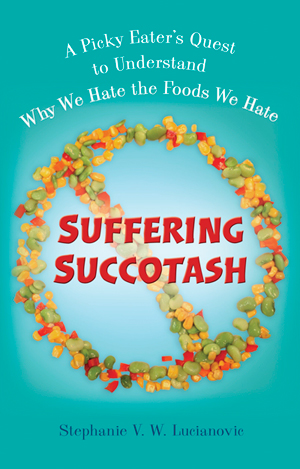by Larissa Zimberoff
Until I read Stephanie Lucianovic’s new book, Suffering Succotash: A Picky Eater’s Quest to Understand Why We Hate the  Foods We Hate, I didn’t quite realize the range in picky eating. I had often referred to myself as a picky eater, the kind of person that only likes good food. Of course I qualified the word good by saying things like healthy, local, organic, or even just tasty. In Stephanie Lucianovic’s book she attempts to determine why kids, and “finicky eating” adults, decide not to eat foods based on looks, taste or feel. Why do we have strong aversions to certain foods and, while we’re at it, what is succotash?
Foods We Hate, I didn’t quite realize the range in picky eating. I had often referred to myself as a picky eater, the kind of person that only likes good food. Of course I qualified the word good by saying things like healthy, local, organic, or even just tasty. In Stephanie Lucianovic’s book she attempts to determine why kids, and “finicky eating” adults, decide not to eat foods based on looks, taste or feel. Why do we have strong aversions to certain foods and, while we’re at it, what is succotash?
Simpler than I imagined, succotash is a mixture of sautéed lima beans, tomatoes and corn. It actually sounded pretty good, but I’m not twelve. Lucianovic grew up as one of those “three more bites and you’re done” kind of kids. She tells us she complained about things touching on her plate, steered clear of any food with a skin and more, subsisting on a narrow list of approved items from the four food groups. Just the cherry from the fruit cup please. Lucianovic had ways to manage the bad foods on her plate; she had places to hide them (try the books in the living room) and physical techniques to swallow them (deep breaths and lots of water). She was a food vanishing magician.
In addition to sharing her own funny stories, like when she was forced to eat “squishy and maple-syruped and gross” squash before she could leave the table, Lucianovic interviews friends and colleagues who were also picky. Like her chef friend Julie, who wouldn’t eat anything that she thought was “’wet,’ like a condiment,” or her friend Jeff, who “has a complex relationship with tomatoes”:
Chunks of tomatoes, like in salsa, are fine, but a quarter of a tomato is too much. What about slices of tomatoes? “I won’t eat them sliced,” Jeff tells me. “In fact, I just pulled one out of my hamburger and threw it out the window on my way home this morning.”
As a compliment to the storytelling, Lucianovic does her best to give a nod to scientific research, both the at-home and in-lab kind. Purchasing a chemistry kit from an online lab supply store to determine if she’s a supertaster or an undertaster, Lucianovic finds out she’s neither. Disappointed with her results, she turns to Dr. Danielle Reed, from the Monell Chemical Senses Center, “the worlds only interdependent, non-profit scientific institute dedicated to research on the senses of taste and smell,” and procures an invite to spend time at their lab, or, as she calls it: DNA Camp. Once there, Lucianovic learns about TAS2r38, one of twenty-five bitter taste receptor genes we inherit, one from each of our parents. And this is where taste gets more complicated. And more interesting.
In addition to TAS2r38, Lucianovic learns about a newly discovered sixth taste. Not just five. Six. Until recently, we learn, our concept of taste was built on sweet, sour, salty, bitter, and umami. Adding to that list, scientists discovered a sixth taste, called calcium/mineral, which a scientist at the lab said tasted, to him, like fat-free milk. This sixth sense piqued my interest, but didn’t get me any closer to the why’s of picky.
The author does provide some very plausible reasons kids are picky: they reject on visual alone; they reject based on family tension at the dinner table; they can’t stand the texture of the food; they have some level of OCD; they have an over eager gag reflex. So here’s my dilemma: How does a non-scientist explain why people eat what they eat and is it at all possible to explain without being anecdotal?
Suffering Succotash: A Picky Eater’s Quest to Understand Why We Hate the Foods We Hate is a unique spin on a serious problem. Both on the kid level, how do you get them to eat their vegetables? And on the adult level, how do you manage telling people you have specific needs? The book is cute, but too light and flip for this picky eater, who wanted an Aha moment along with her small yield, heirloom lima beans from California.
To read an interview with the author, click here!
Suffering Succotash: A Picky Eater’s Quest to Understand Why We Hate the Foods We Hate
By Stephanie Lucianovic
Perigee Books, Published July 3, 2012
Larissa Zimberoff is a freelance writer living in Manhattan. She is currently working towards her MFA at The New School. Her writing has appeared in Salon, Untapped Cities and The Rumpus.


2 Comments
Pingback: Interview with Stephanie V. W. Lucianovic, author of Suffering Succotash | The Inquisitive Eater
Meladerm suits the bill, because it uses extracts of licorice and mulberry as its energetic ingredients, which means
you do not must be worried about unneeded chemical substances.